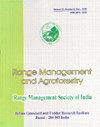燕麦产量性状和抗白粉病诱导遗传变异的评价
IF 0.8
4区 农林科学
Q3 AGRONOMY
引用次数: 0
摘要
为诱导小麦抗白粉病和产量性状的遗传变异,采用γ射线(200、300、400 Gy)和EMS(0.3%、0.6%、0.9% v/v)及其组合处理了HJ-8和Kent两个燕麦品种。记录拉比2018年M代白粉病反应、发芽率(%)和存活率(%)。采用扩增区设计对拉比2019的12个不同产量性状、叶绿素突变体和白粉病抗性进行筛选。经Probit分析,EMS- 50处理的HJ-8和Kent品种的LD值分别为1.40%和0.84%,表明不同基因型的LD值存在差异。在M代联合处理下,两个品种的抗白粉病突变体数量最多。在M代观察到5个叶绿素突变体1。HJ-8的最高诱变效力为0.9% EMS,而Kent的最高诱变效力为0.3%。方差分析表明,各处理均产生了充分的变异。高遗传力与高遗传进展(开花起始天数、单株生物产量、单株籽粒产量、收获指数和百粒重)表明,加性基因作用的环境效应可以忽略不计。单株籽粒产量与单株生物产量和百粒重呈极显著正相关并直接影响。最大M个突变体是2个唯一的,因为它们落在pca双象限的不同象限。在M代获得33个推定的白粉病抗性突变体。这些假定的突变体可用于燕麦改良计划。本文章由计算机程序翻译,如有差异,请以英文原文为准。
Assessment of induced genetic variability for yield traits and powdery mildew resistance in oat
To induce genetic variability in oat for powdery mildew resistance and yield traits, two cultivars of oat viz., HJ-8 and Kent were treated with gamma rays (200 Gy, 300 Gy and 400 Gy), EMS (0.3%, 0.6% and 0.9% v/v) and their respective combinations. Powdery mildew disease reaction, germination (%) and survivability (%) were recorded for M generation during Rabi 2018. M generation was screened in augmented block design for 1 2 various yield traits, chlorophyll mutants and powdery mildew resistance in Rabi 2019. LD values of EMS- 50 treated HJ-8 and Kent cultivars were 1.40% and 0.84%, respectively using Probit analysis, which indicated that LD value varied from genotype to genotype. The highest number of powdery mildew-resistant putative 50 mutants for both cultivars was observed for combined treatments in M generation. Five chlorophyll mutants 1 were observed in M generation. The highest mutagenic effectiveness for HJ-8 was observed for 0.9% EMS, 2 while in case of Kent, it was 0.3%. Analysis of variance revealed sufficient variation was generated in the treatments for all the traits. High heritability coupled with high genetic advance recorded for days to flowering initiation, biological yield per plant, grain yield per plant, harvest index and 100-grain weight indicated additive gene action with negligible environmental effects. Grain yield per plant showed a significant positive correlation and direct effect with biological yield per plant and 100-grain weight. Maximum M mutants were 2 unique as they fall in different quadrants of PCA-biplot. Thirty-three putative mutants resistant to powdery mildew were obtained in M generation. These putative mutants could be used in oat improvement programme.
求助全文
通过发布文献求助,成功后即可免费获取论文全文。
去求助
来源期刊

Range Management and Agroforestry
AGRONOMY-
CiteScore
1.50
自引率
62.50%
发文量
25
审稿时长
>12 weeks
期刊介绍:
The Society has been established with the following objectives:
1. To advance the cause of research activity in all aspects of rangelands and to encourage and promote the studies on rangeland, wasteland ecosystems and agroforestry.
2. To provide facilities for seminars and conferences to rangeland researchers, development workers and farmers and to encourage close cooperation with organizations having related aims and interests.
3. To disseminate the knowledge of scientific agriculture and technology for forage and rangeland production, improvement and management.
 求助内容:
求助内容: 应助结果提醒方式:
应助结果提醒方式:


